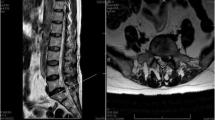Abstract
The medical profession is increasingly confronted with the epidemic phenomenon of obesity. Its impact on spine surgery is not quite clear. Published data concerning the use of minimally invasive surgery (MIS) in the spine among obese patients is scarce. The purpose of the present retrospective study was to evaluate perioperative as well as postoperative complication rates in MIS fusion of the lumbar spine in obese, overweight and normal patients classified according to their body mass index. Lumbar MIS fusion was performed by means of TLIF procedures and/or posterolateral fusion alone. A laminotomy was performed in patients with spinal stenosis. Of 72 patients, 39 underwent additional laminotomy for spinal stenosis. No differences were registered in respect of the numbers of fused segments or cages. Any harmful event occurring peri- or postoperatively was noted and included in the statistical analysis. No infection at the site of surgery or severe wound healing disorder was encountered. We registered no difference in blood loss, drainage, or the length of the hospital stay between the three BMI groups. We also observed no difference in complication rates between the three groups. This study confirms the low soft tissue damage of minimal access surgery techniques, which is an important type of surgery in obese patients. The smaller approach helps to minimize infections and wound healing disorders. Moreover, deeper regions of wounds are clearly visualized with the aid of tubular retractors.
Similar content being viewed by others
References
Caballero B (2007) The global epidemic of obesity: an overview. Epidemiol Rev 29:1–5. doi:10.1093/epirev/mxm012
Knai C, Suhrcke M, Lobstein T (2007) Obesity in eastern Europe: an overview of its health and economic implications. Econ Hum Biol 5(3):392–408. doi:10.1016/j.ehb.2007.08.002
Patel N, Bagan B, Vadera S, Maltenfort MG, Deutsch H, Vaccaro AR, Harrop J, Sharan A, Ratliff JK (2007) Obesity and spine surgery: relation to perioperative complications. J Neurosurg Spine 6(4):291–297. doi:10.3171/spi.2007.6.4.291
Kardaun JW, White LR, Shaffer WO (1990) Acute complications in patients with surgical treatment of lumbar herniated disc. J Spinal Disord 3(1):30–38
Telfeian AE, Reiter GT, Durham SR, Marcotte P (2002) Spine surgery in morbidly obese patients. J Neurosurg 97(1 Suppl):20–24
Ntoukas V, Muller A (2010) Minimally invasive approach versus traditional open approach for one level posterior lumbar interbody fusion. Minim Invasive Neurosurg 53(1):21–24. doi:10.1055/s-0030-1247560
Park Y, Ha JW (2007) Comparison of one-level posterior lumbar interbody fusion performed with a minimally invasive approach or a traditional open approach. Spine (Phila Pa 1976) 32(5):537–543. doi:10.1097/01.brs.0000256473.49791.f4
Scheufler KM, Dohmen H, Vougioukas VI (2007) Percutaneous transforaminal lumbar interbody fusion for the treatment of degenerative lumbar instability. Neurosurgery 60(4 Suppl 2):203–212. doi:10.1227/01.NEU.0000255388.03088.B7 (discussion 212–213)
Foley KT, Holly LT, Schwender JD (2003) Minimally invasive lumbar fusion. Spine (Phila Pa 1976) 28(15 Suppl):S26–S35. doi:10.1097/01.BRS.0000076895.52418.5E
Foley KT Smith M (1997) Microendoscopic discectomy. Tech Neurosurg (3):301–307
Holly LT, Schwender JD, Rouben DP, Foley KT (2006) Minimally invasive transforaminal lumbar interbody fusion: indications, technique, and complications. Neurosurg Focus 20(3):E6 (pii:200306)
Park P, Upadhyaya C, Garton HJ, Foley KT (2008) The impact of minimally invasive spine surgery on perioperative complications in overweight or obese patients. Neurosurgery 62(3):693–699. doi:10.1227/01.neu.0000317318.33365.f1 (discussion 693–699)
Andreshak TG, An HS, Hall J, Stein B (1997) Lumbar spine surgery in the obese patient. J Spinal Disord 10(5):376–379
Hanigan WC, Elwood PW, Henderson JP, Lister JR (1987) Surgical results in obese patients with sciatica. Neurosurgery 20(6):896–899
Yadla S, Malone J, Campbell PG, Maltenfort MG, Harrop JS, Sharan AD, Vaccaro AR, Ratliff JK (2010) Obesity and spine surgery: reassessment based on a prospective evaluation of perioperative complications in elective degenerative thoracolumbar procedures. Spine J 10(7):581–587. doi:10.1016/j.spinee.2010.03.001
Gepstein R, Shabat S, Arinzon ZH, Berner Y, Catz A, Folman Y (2004) Does obesity affect the results of lumbar decompressive spinal surgery in the elderly? Clin Orthop Relat Res (426):138–144 (pii:00003086-200409000-00023)
Wimmer C, Gluch H, Franzreb M, Ogon M (1998) Predisposing factors for infection in spine surgery: a survey of 850 spinal procedures. J Spinal Disord 11(2):124–128
Olsen MA, Mayfield J, Lauryssen C, Polish LB, Jones M, Vest J, Fraser VJ (2003) Risk factors for surgical site infection in spinal surgery. J Neurosurg 98(2 Suppl):149–155
Djurasovic M, Bratcher KR, Glassman SD, Dimar JR, Carreon LY (2008) The effect of obesity on clinical outcomes after lumbar fusion. Spine 33(16):1789–1792. doi:10.1097/BRS.0b013e31817b8f6f
Friedman ND, Sexton DJ, Connelly SM, Kaye KS (2007) Risk factors for surgical site infection complicating laminectomy. Infect Control Hosp Epidemiol 28(9):1060–1065. doi:10.1086/519864
Cole JS, Jackson TR (2007) Minimally invasive lumbar discectomy in obese patients. Neurosurgery 61(3):539–544. doi:10.1227/01.NEU.0000290900.23190.C9 (discussion 544)
Kim KT, Lee SH, Suk KS, Bae SC (2006) The quantitative analysis of tissue injury markers after mini-open lumbar fusion. Spine (Phila Pa 1976) 31(6):712–716. doi:10.1097/01.brs.0000202533.05906.ea
Carreon LY, Puno RM, Dimar JR 2nd, Glassman SD, Johnson JR (2003) Perioperative complications of posterior lumbar decompression and arthrodesis in older adults. J Bone Jt Surg Am 85-A(11):2089–2092
Shunwu F, Xing Z, Fengdong Z, Xiangqian F (2010) Minimally invasive transforaminal lumbar interbody fusion for the treatment of degenerative lumbar diseases. Spine (Phila Pa 1976) 35(17):1615–1620. doi:10.1097/BRS.0b013e3181c70fe3
Lubansu A (2010) Minimally invasive spine arthrodesis in degenerative spinal disorders. Neurochirurgie 56(1):14–22. doi:10.1016/j.neuchi.2009.12.002
Glotzbecker MP, Bono CM, Wood KB, Harris MB (2010) Postoperative spinal epidural hematoma: A systematic review. Spine (Phila Pa 1976) 35(10):E413–E420. doi:10.1097/BRS.0b013e3181d9bb77
Acknowledgments
No funds or other benefits were received in support of this study.
Conflict of interest
None.
Author information
Authors and Affiliations
Corresponding author
Electronic supplementary material
Below is the link to the electronic supplementary material.
Rights and permissions
About this article
Cite this article
Senker, W., Meznik, C., Avian, A. et al. Perioperative morbidity and complications in minimal access surgery techniques in obese patients with degenerative lumbar disease. Eur Spine J 20, 1182–1187 (2011). https://doi.org/10.1007/s00586-011-1689-6
Received:
Revised:
Accepted:
Published:
Issue Date:
DOI: https://doi.org/10.1007/s00586-011-1689-6




